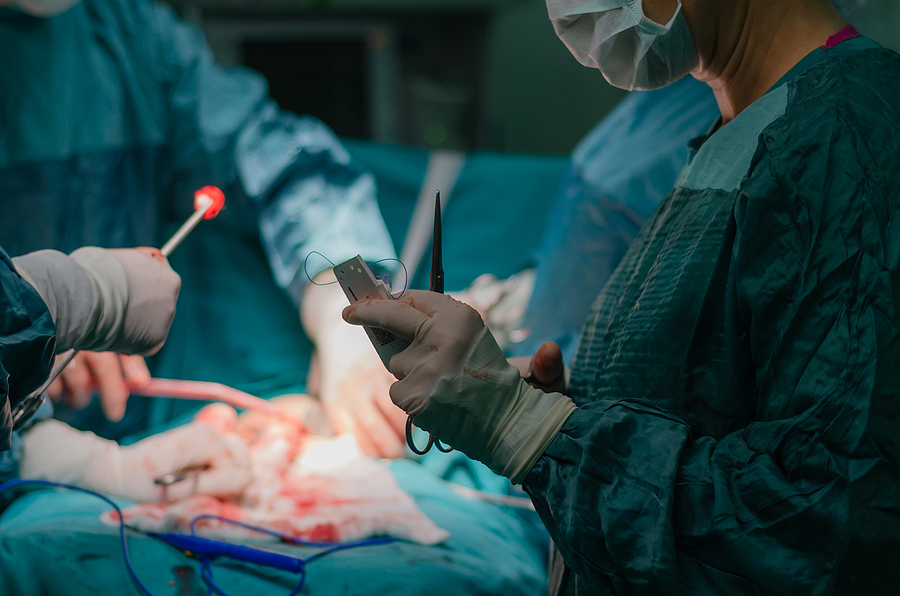
Hysterectomy Alternatives for Fibroids
If you suffer from symptomatic uterine fibroids, we want you to know that help is available. Treatment options can alleviate symptoms such as heavy periods, severe cramps, frequent urination, and painful sex. There’s no need to suffer from fibroid symptoms any longer.
Many women with fibroids avoid treatment because they believe a hysterectomy is the only option, but this isn’t the case. We want you to know about a highly effective, non-surgical hysterectomy alternative that can shrink your fibroids and alleviate symptoms with minimal risk, a shorter recovery, and no hospital stay. The uterus is left fully intact so that future pregnancy is possible.
At USA Fibroid Centers, our fibroid specialists can help you explore your treatment options. We want you to be fully informed about fibroids, hysterectomy, and a minimally invasive fibroid treatment known as uterine fibroid embolization (UFE).
Do You Have to Have a Hysterectomy for Fibroids?
Hysterectomy, or the surgical removal of your uterus, is not the only way to treat fibroids. If you are considering having a hysterectomy for fibroids, it is important to understand that this treatment has several risks.
A hysterectomy involves a hospital stay and a lengthy recovery of six to eight weeks. It also involves surgical risks like an adverse reaction to general anesthesia, excessive bleeding, blood clots, and infection. Post-surgery complications resulting from a hysterectomy include possible damage to the surrounding organs, potentially leading to incontinence, fistula formation, or vaginal prolapse.
Sometimes ovaries are surgically removed during a hysterectomy, triggering the onset of menopause and additional symptoms.
Additionally, for some women, the loss of the uterus is devastating—most notably for premenopausal women. If you wish to become pregnant in the future, there are alternatives to hysterectomy for fibroids that can eliminate painful, uncomfortable, and inconvenient fibroid symptoms without impacting fertility.
Request a Consultation With a Fibroid Specialist
Alternatives to Hysterectomy for Fibroids
There are several approaches to fibroid removal without hysterectomy, including both surgical and non-surgical methods. At USA Fibroid Centers, we specialize in a minimally invasive, outpatient hysterectomy alternative called uterine fibroid embolization (UFE). UFE offers many advantages over hysterectomy, which we will discuss further below.
Although we believe UFE is the best fibroid treatment available, our fibroid specialists are prepared to discuss all of your options. Ultimately, our primary goal is to help you make an informed treatment decision.
What Are the Alternatives to a Hysterectomy for Treating Fibroids?
Contrary to popular belief, there are multiple alternatives to hysterectomy for fibroids. These include:
Uterine Fibroid Embolization (UFE)
Uterine fibroid embolization is a minimally invasive outpatient procedure that shrinks fibroids and can alleviate associated symptoms. Treatment is performed in a clinic setting and does not require general anesthesia, a hospital stay, or a lengthy recovery.
During UFE, an interventional radiologist uses ultrasound imaging to map your fibroids. Then, they thread a tiny catheter through an entry point in your numbed upper thigh. Next, they inject embolic materials through this catheter and into the main uterine artery. This process cuts off your fibroid(s) from blood flow and nutrients. Over time, your fibroid should shrink, and your symptoms resolve.
After UFE, you can go home the same day to begin your short recovery. Most women return to normal activities within one to two weeks.
Benefits of UFE include:
- Minimally invasive treatment
- Office-based procedure
- Less risk than surgery
- Short recovery of 1–2 weeks
- No stitches or scarring
- Highly effective
- Retains fertility
For more information on the benefits of uterine fibroid embolization over hysterectomy, please visit our article entitled UFE vs. Hysterectomy.
Myomectomy
While a hysterectomy removes the entire uterus, a myomectomy is a surgical procedure that removes the fibroids themselves. Afterward, the uterus is reconstructed. When a large number of fibroids are present, myomectomy is not typically advised.
There are several variations of myomectomy: abdominal, laparoscopic, and hysteroscopic. Which one is recommended depends on the size, location, and the number of fibroids involved. The type performed determines your length of recovery, which can range from a few days up to six weeks. A hospital stay and general anesthesia are often required.
For those planning to get pregnant, myomectomy isn’t a great option as the procedure can cause the uterine walls to weaken or thin, making a viable pregnancy difficult.
If you are looking for a less-invasive alternative to hysterectomy, UFE may be a better option than a myomectomy. For more information on uterine fibroid embolization’s benefits over myomectomy, visit our helpful page Myomectomy vs. UFE.
Uterine Fibroid Ablation
Fibroid ablation, such as the Acessa procedure, is a minimally invasive technique that uses heat to reduce uterine fibroids. Ablation is performed in an operating room under anesthesia. It involves multiple small incisions into the abdominal region in which to insert small medical instruments. Most women recover within four to five days. Symptoms begin to improve during the following weeks to months.
Although there are pros involved with fibroid ablation, there are also some cons to discuss that may ultimately guide you to choose UFE instead. There is the possibility of skin burns and damage to nearby organs. Finally, there is insufficient data at this point to know how fibroid ablation affects future fertility.
Additionally, the Acessa ablation procedure is a more recently approved treatment than UFE or fibroid surgery, so many health insurance plans d
on’t cover it. You may also need to travel to find an experienced practitioner.
To learn about Uterine Fibroid Embolization’s benefits over fibroid ablation, review our articles at UFE vs. Acessa Procedure and UFE vs. Fibroid Ablation.
Medications
Medications, including birth control pills and IUDs, are prescribed to control fibroid symptoms like heavy periods and severe menstrual cramps. However, they do not treat the underlying problem, the fibroids themselves. Therefore, medications are not a true alternative to a hysterectomy.
Understanding Fibroid Treatment Alternatives
At USA Fibroid Centers, we believe that all women should understand their fibroid treatment options other than hysterectomy. During an initial consultation with one of our fibroid specialists, we can review your medical history, assess your symptoms, perform a physical exam, order imaging (if necessary), and discuss UFE procedure and recovery.
Schedule an Initial Consultation
What Else Should I Know?
Many factors should be considered when choosing your fibroid treatment. Some of these include your age, general health, and desire to become pregnant in the future. Additionally, the location, number, and size of your fibroids are important factors in determining the best treatment method.
When it comes to large fibroids, hysterectomy is one potential option; however, we are frequently asked about hysterectomy alternatives for large fibroids. In most cases, uterine fibroid embolization can be used as a safe, effective treatment for fibroids of all sizes.
Another aspect to consider when deciding on treatment: The Food and Drug Administration (FDA) recently issued guidance on a piece of equipment often used in hysterectomy and myomectomy called a laparoscopic power morcellator. This device can spread benign tissue associated with parasitic myomas (a type of a pedunculated subserosal fibroid that is detached from the uterus), disseminated peritoneal leiomyomatosis (a very rare condition involving small lumps of smooth muscle cells in the abdominal region) and uterine sarcoma (a cancer that develops in soft tissue or bones). Using a laparoscopic power morcellator may increase the risk of spreading undetected cancer within the abdomen.
If you are considering a hysterectomy for fibroids, we recommend researching UFE as a treatment option other than a hysterectomy. Our highly experienced specialists are on hand to get you started.
Why Shouldn’t I Get a Hysterectomy for Fibroids?
Although everyone’s situation is different, there are several potential reasons why you shouldn’t get a hysterectomy. However, we recommend discussing your personal circumstances with a fibroid specialist.
The downsides of hysterectomy include:
- Requires general anesthesia, a hospital stay, and stitches
- Unnecessary exposure to surgical risks like excessive bleeding, infection, blood clots, and adverse reaction to anesthesia
- A lengthy recovery of six to eight weeks
- If ovaries are removed, potential for early menopause
Infertility - Hormone replacement therapy is usually needed
- A permanent and irreversible procedure
Perhaps the most important thing to remember is that there are alternatives to hysterectomy for fibroids that avoid these complications. Uterine fibroid embolization can shrink your fibroids, eliminate your symptoms, leave your uterus fully intact, and quickly get you back to normal daily activities. Before undergoing an irreversible procedure, we hope you’ll consider one of the best fibroid treatments available.
Contact USA Fibroid Centers Today!
When you’re ready to learn more about uterine fibroid embolization and other options for fibroid removal without a hysterectomy, we’re here for you. We can also provide an initial fibroid diagnosis and answer your questions about fibroid causes.
You can schedule an appointment online, visit one of the dozens of USA Fibroid Centers nationwide, and/or consult one of our leading experts during a convenient telemedicine visit. We look forward to helping you regain control of your life.



